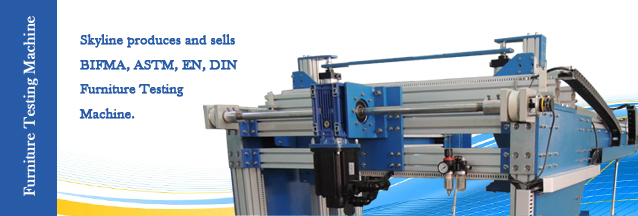 Toys Testing Equipment
Toys Testing Equipment Footwear Testing Equipment
Footwear Testing Equipment Tensile Testing Machine
Tensile Testing Machine Environmental Test Chamber
Environmental Test Chamber Building Material Flammability Test Equipment
Building Material Flammability Test Equipment Paper Testing Equipment
Paper Testing Equipment Spectacle Frames Testing Equipment
Spectacle Frames Testing Equipment Oil Analysis Testing Equipment
Oil Analysis Testing Equipment Lab Test Equipment
Lab Test Equipment Electronic Testing Equipment
Electronic Testing Equipment Stationery Testing Equipment
Stationery Testing Equipment Flammability Test Equipment
Flammability Test Equipment Furniture Testing Machine
Furniture Testing Machine Textile Testing Equipment
Textile Testing Equipment
 How to evaluate the corrosion resistance of lubricating grease?
How to evaluate the corrosion resistance of lubricating grease? - 2026/1/2
- How to evaluate the corrosion resistance of lubricating grease? A comprehensive guide to lubricating grease corrosion resistance testing and professional testing equipment. A tiny corrosion spot in...
 The Hong Kong fire once again rings the alarm: How can laboratories build a safety defense line for building materials through combustion tests?
The Hong Kong fire once again rings the alarm: How can laboratories build a safety defense line for building materials through combustion tests?- 2025/12/25
- The Hong Kong fire once again rings the alarm: How can laboratories build a safety defense line for building materials through combustion tests? The recent serious fire accident in Hong Kong has s...
 The Indian furniture inspection market welcomes new regulations!
The Indian furniture inspection market welcomes new regulations!- 2025/11/28
- The Indian furniture inspection market welcomes new regulations! The demand for these testing instruments will soar in 2026. New regulations in India are about to come into effect, and furniture insp...
- More>
What Is Fire Testing Equipment Steiner Tunnel Test Apparatus?
What does the Steiner tunnel test assess?
Steiner Tunnel tests measure the surface burning characteristics of interior finish materials and assemblies used in buildings, which is critical to understanding how materials react during a fire.
Product Feature and Application
1. The stainless steel combustion test box body has a brick structure inside, which can resist the flame impact and has good thermal insulation performance;
2. Double-layer quartz glass observation window, can observe the flame spread distance, and record;
3. Using the indicator light recording method, the flame spread distance can be recorded more intuitively;
4. The cooling water circulation support bracket can support the combustion cover such as calcium silicate board;
5. Equipped with 2mm thick 304 stainless steel water seal groove to ensure that the smoke does not leak during the test;
6. 304 stainless steel insulation body cover, filled with high temperature insulation material;
7. Equipped with an escalator sample installation platform to facilitate the installation, removal of samples and inspection of the furnace;
8. Independent multi-function exhaust pressure detecting device: real-time monitoring of exhaust pressure changes during testing. Detection range 0~250Pa, accuracy ±0.5Pa, system indication pressure test accuracy ±2Pa;
9. Fan: 380V, 50Hz, 3Kw equipped with frequency converter can change the wind speed, the flow rate is at least 8000m3/h, and the flue gas generated by the sample combustion can be discharged out of the room in time to ensure the safety of the test;
10. Double-head gas burner: It can output standard 5.3MJ/min heat, and can control the gas flow rate by mass flow meter according to different standards. The measuring range is 0~160L/min, which can change the calorific value output of the burner and the maximum output. Energy up to 100MJ/min;
11. Automatic ignition system: to ensure the safety of the test, high-voltage igniter, 44KV, 50mA, the minimum high voltage of the ignition electrode is 1.8kVp;
12. Smoke density system: Provide a separate signal processing system to ensure that the sensor is linear;
13. Automatically record temperature and smoke sensing signals, and the sample collection frequency is 1 Hz;
14. Mass flow controller: 316 stainless steel material, the maximum pressure of 1000psig (70bar), leakage rate is less than 1 × 10-7sml / s, NIST calibration, 0 ~ 5VDC and 4 ~ 20mA signal, loop protection, propane flow range 0 ~ 2.3g / s, control speed ≤ 2s, control accuracy of ± 1% FS, repeatability ± 0.5FS, temperature range 0 ~ 50 ° C, humidity range 0 ~ 90%, digital display, automatic The gas supply meets the 5000Btu (5.3MJ)/min heat requirement during the control test, and the software automatically records the amount of gas used;
15. Standard test software can automatically record test data such as system wind speed, temperature and smoke density.
Product Details
UL910/NFPA262 Steiner horizontal tunnel furnace is mainly used for the flame retardant performance test of CMP grade wire and cable. It is mainly used for cables in horizontal subsystems that are directly laid in ventilation or forced ventilation without metal pipelines. The flame retardant test standard represents the most stringent flame retardant test standard for UL and even the entire wire and cable flame retardant test. Only the fluorine material sheath cable can pass the flame retardant test method. Due to the high decomposition temperature of fluoroplastics (greater than 400 degrees), the ignition point is also high (800 degrees or more), and it is not easy to burn when the fire is not strong, so it has better fire resistance than other organic materials.
The purpose of this test is to determine whether the flame-propagation and smoke-generating characteristics of cables without raceways are within the limits specified in the National Electrical Code (NEC). Cables having adequate fire-resistant and low-smoke-producing characteristics need not comply with general wiring methods when the cables are installed (without raceways) in environmental-air ducts, concealed hollow building spaces used as ducts for environmental air, and other environmental-air-handling spaces not specifically excluded (areas involving grease and flammable dust, vapor, and the like). This test method is essentially the same as the test method described in the Standard Method of Test for Fire and Smoke Characteristics of Wires and Cables, NFPA 262.
Application:It is mainly used for cables in horizontal subsystems that are directly laid in a ventilated or forced air environment without using metal pipelines.
Standards:NFPA 262 UL910
Dimension:21300 mm (L) x 1100 mm (D) x 2100 mm (H)
Weight:1770kg
Electrical: 115 Volts AC 60Hz / 230 Volts AC 50Hz.
Installation requirements
Electrical: 380 Volts AC, 20KW
Ambient Temperature: Operating 15°C to 35°C.
Gas: Methane and air compressor
Utility: Crane
- ·New type Crockmeter- Manual Is Newly Released!
- ·Chinese New Year's Holiday!
- ·Skyline Instruments to SASO Installing and Training with a perfect Ending
- ·2014 New Design Toys 2m/s. Dynamic Strength Tester
- ·In 2014, the latest launched Caster and Chair Base Durability Tester
- ·The Blockbuster Launched Chair Stability Tester

 Toys Testing Equipment
Toys Testing Equipment Footwear Testing Equipment
Footwear Testing Equipment Tensile Testing Machine
Tensile Testing Machine Environmental Test Chamber
Environmental Test Chamber Building Material Flammability Test Equipment
Building Material Flammability Test Equipment Paper Testing Equipment
Paper Testing Equipment Spectacle Frames Testing Equipment
Spectacle Frames Testing Equipment Oil Analysis Testing Equipment
Oil Analysis Testing Equipment Lab Test Equipment
Lab Test Equipment Electronic Testing Equipment
Electronic Testing Equipment Stationery Testing Equipment
Stationery Testing Equipment Flammability Test Equipment
Flammability Test Equipment Furniture Testing Machine
Furniture Testing Machine Textile Testing Equipment
Textile Testing Equipment

 English
English 中文
中文 Español
Español française
française العربية
العربية Русский
Русский







